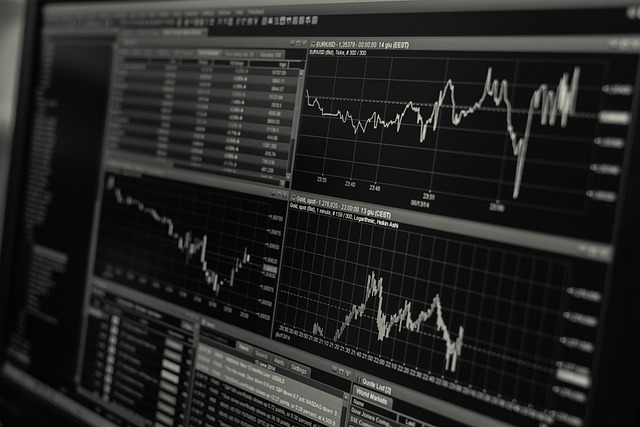Do Day Trading Bots Work? An In-Depth Review
Author: Jameson Richman Expert
Published On: 2025-09-05
Prepared by Jameson Richman and our team of experts with over a decade of experience in cryptocurrency and digital asset analysis. Learn more about us.
In the fast-paced and often unpredictable world of financial markets, automation tools like day trading bots have revolutionized the way traders approach short-term trading. These sophisticated algorithms are designed to execute trades at lightning speed, analyze vast datasets in real-time, and remove the emotional and psychological biases that often impair human decision-making. The allure of consistent profits, minimized emotional stress, and the ability to operate 24/7 makes these bots highly attractive, especially in highly volatile markets such as cryptocurrencies, forex, and stocks. However, despite the technological advancements and initial enthusiasm, the core question persists: Do day trading bots truly live up to their promises, or are they overhyped solutions that fall short when faced with real-world market complexities? Drawing from extensive hands-on experience with various trading bots, strategies, and market conditions, this comprehensive review aims to dissect their capabilities, limitations, and best practices for effective deployment.

Understanding Day Trading Bots and Their Core Functionality
Day trading bots are automated software programs engineered to execute buy and sell orders based on algorithms, predefined rules, or machine learning models. Their primary goal is to capitalize on short-term price movements while eliminating human shortcomings such as emotional reactions, fatigue, and inconsistent discipline. These bots operate by continuously analyzing multiple data streams—including live price feeds, technical indicators, order book depth, and sometimes even external sentiment data from news outlets or social media—to identify optimal entry and exit points within milliseconds or microseconds. They are capable of managing orders dynamically, adjusting stop-loss or take-profit levels in real-time, and executing high-frequency trades that would be impossible for manual traders. Their core functions encompass order placement, risk management, position sizing, and market surveillance—optimized to exploit fleeting volatility and generate consistent, if not guaranteed, returns.
Types of Trading Bots
- Rule-Based Bots: These operate strictly on fixed, deterministic algorithms derived from technical analysis indicators such as moving averages, RSI, MACD, Fibonacci retracements, or candlestick patterns. Their logic is transparent and easily customizable, making them accessible for traders who prefer clear, rule-driven strategies. However, their rigidity can become a weakness during unpredictable market conditions, leading to false signals or missed opportunities.
- Machine Learning Bots: Employing advanced AI and deep learning, these bots analyze large datasets—both historical and real-time—to adapt strategies dynamically. They can recognize complex, non-linear patterns that might elude traditional algorithms, potentially improving over time. Nonetheless, they require substantial computational resources, high-quality data, and expert tuning to prevent overfitting, which can cause poor performance in live trading environments.
- Arbitrage Bots: Designed to exploit price discrepancies for the same asset across multiple exchanges or markets, these bots demand ultra-low latency infrastructure, as opportunities often last mere milliseconds. While highly profitable for institutional traders with advanced infrastructure, retail traders typically find arbitrage bots impractical due to infrastructural and cost constraints.
- Market Making Bots: These place simultaneous buy and sell limit orders around the current market price to earn the bid-ask spread. They contribute liquidity and earn small, consistent profits. Market makers often deploy these bots within regulated environments or within platforms that support high-frequency trading, requiring sophisticated risk controls to manage inventory and adverse selection risks.
Do Day Trading Bots Actually Work? My Perspective and Insights
From my extensive experience in active trading and bot deployment, I can affirm that day trading bots can be effective tools but are far from foolproof or guaranteed sources of profit. Their success largely depends on strategy quality, market conditions, and ongoing management. When correctly configured—based on thorough analysis, rigorous backtesting, and real-time adjustments—they can process data and execute trades faster than humanly possible, capturing opportunities in volatile markets with precision. Nonetheless, markets are inherently unpredictable, influenced by macroeconomic events, geopolitical shocks, and sudden liquidity shifts that no algorithm can foresee perfectly. During high-impact news releases or systemic shocks, bots may malfunction, execute poorly, or generate losses. Therefore, reliance solely on automation without proper oversight can be perilous. Ultimately, the effectiveness of trading bots is not absolute but context-dependent. Proper understanding and integration into a broader trading plan are crucial for success.
The Importance of Strategy and Customization
A generic, one-size-fits-all bot is unlikely to perform consistently over time. Crafting a profitable automated trading system demands meticulous customization tailored to specific markets, asset classes, timeframes, and volatility profiles. For example, a bot optimized for the highly volatile crypto markets—like Bitcoin or altcoins—must handle rapid price swings, false signals, and liquidity gaps differently than a forex or stock bot. Key to this process is the integration of multiple technical indicators—such as RSI for overbought/oversold conditions, MACD for trend confirmation, Bollinger Bands for volatility, and volume analysis—to refine entry and exit points. Fine-tuning parameters like stop-loss levels, take-profit targets, and position sizes based on historical data helps prevent overfitting and enhances robustness amid changing market regimes. A well-customized bot adapts to market nuances, reducing the likelihood of unexpected drawdowns and fostering sustainable profitability.
Backtesting and Data-Driven Decisions
Rigorous backtesting on historical data is an indispensable step before deploying any trading bot live. This process involves evaluating strategy performance across diverse market conditions—bullish trends, bearish downturns, sideways consolidations, and volatile spikes—to gauge resilience and profitability. However, overfitting remains a common pitfall; a strategy too tightly tuned to past data may perform poorly in real-time markets. Techniques such as walk-forward testing, out-of-sample validation, and paper trading are essential to verify robustness. Forward-testing with simulated or small live accounts allows traders to observe how strategies behave under real-world slippage, latency, and order execution delays. Continuous refinement based on live performance data ensures the strategy remains adaptable, helping traders avoid costly mistakes rooted in false confidence from backtest results alone.
Risk Management and Continuous Monitoring
Effective risk management is the backbone of profitable automated trading. Essential safeguards include dynamic stop-loss orders, trailing stops to lock in profits, position sizing algorithms tailored to volatility, and diversification across multiple assets or strategies to prevent overexposure. Markets can shift rapidly—driven by geopolitical events, economic data releases, or systemic shocks—potentially turning profitable trades into losses. Continuous monitoring of bot performance, market conditions, and risk parameters is crucial. Regularly reviewing trading logs, performance metrics, and adjusting parameters or disabling underperforming bots helps prevent catastrophic drawdowns. Automated alerts, manual intervention protocols, and strict capital allocation rules further safeguard trading capital and ensure long-term sustainability.
Common Pitfalls and Lessons Learned
Throughout my journey in algorithmic trading, several recurring pitfalls have emerged—many of which can be avoided with proper awareness and discipline:
- Over-Optimization: Excessive fine-tuning of parameters to historical data—also known as curve fitting—can lead to strategies that perform spectacularly in backtests but fail miserably in live markets due to overfitting or regime shifts.
- Ignoring Market Conditions: Rigid strategies that do not adapt to changing volatility, liquidity, or trend strength tend to underperform during unpredictable or turbulent periods, leading to drawdowns or losses.
- Lack of Risk Controls: Relying solely on profit targets without adequate safeguards like stop-losses exposes portfolios to severe risk during sudden adverse moves, often resulting in disproportionate losses.
- Set-and-Forget Mindset: Expecting bots to run flawlessly without active oversight often results in missed signals, unanticipated losses, or prolonged periods of underperformance. Markets demand ongoing strategy refinement, parameter adjustments, and sometimes disabling or reconfiguring bots in response to evolving conditions.

How to Choose and Use Effective Trading Platforms
The choice of trading platform is fundamental to deploying successful bots. Major exchanges like Binance, MEXC, Bitget, and Bybit are favored due to their robust APIs, security features, and active developer communities. When selecting a platform, consider:
- API Stability and Documentation: Reliable, well-documented APIs enable seamless integration, low-latency execution, and debugging, reducing operational risk.
- Security Measures: Platforms should employ strong security practices—such as two-factor authentication, IP whitelisting, and encryption—to safeguard your assets against hacks and unauthorized access.
- User Support and Community: Active support channels, developer forums, and shared resources can facilitate troubleshooting, share strategies, and improve your bot development process.
- Simulation and Testing Environments: Demo accounts or sandbox environments allow for comprehensive testing of strategies and bots without risking real funds, boosting confidence before live deployment.
Risks and Limitations of Day Trading Bots
Despite their advantages, trading bots are not infallible and come with inherent risks. They cannot predict rare, extreme market events—known as black swan events—such as geopolitical crises, regulatory crackdowns, or unexpected news shocks. High-frequency arbitrage and market-making bots often require significant infrastructural investments—like colocated servers, fiber optic connections, and ultra-low latency setups—placing them out of reach for most retail traders. Moreover, in illiquid markets or during sudden volatility spikes, bots can experience slippage, increased spreads, or execution failures. These limitations stress the importance of manual oversight, continuous education, and conservative capital management to prevent catastrophic losses and ensure long-term viability of automated strategies.
Conclusion: Are Day Trading Bots Worth It?
In summary, day trading bots are potent tools capable of executing precise, high-speed trades, removing emotional biases, and scaling trading activities efficiently. They excel at processing vast amounts of data and executing orders faster than humans, which can be particularly advantageous in volatile, fast-moving markets. However, their success is not guaranteed—markets are inherently unpredictable, influenced by macroeconomic factors, news events, and systemic shocks that no algorithm can fully anticipate. Therefore, bots should be viewed as valuable supplementary tools rather than standalone solutions. Their effectiveness depends heavily on proper strategy design, continuous optimization, and active oversight.
To maximize their potential, traders must deeply understand their mechanics, constantly refine strategies based on real-world data, and select reliable platforms like Binance, MEXC, Bitget, and Bybit—renowned for their API stability, security, and supportive communities. Incorporating rigorous risk management, ongoing education, and adaptability into your trading approach is essential for sustainable success. Approaching automated trading with cautious optimism, prioritizing capital preservation, and maintaining active involvement will significantly improve outcomes. Ultimately, when used wisely as part of a comprehensive trading plan, day trading bots can be powerful allies—helping traders harness market opportunities with speed and discipline.